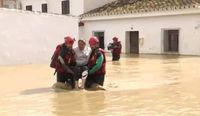Spain is currently grappling with a severe weather crisis in the southern region of Andalusia, where continuous heavy rains have led to flash floods wreaking havoc across several municipalities, particularly in Malaga. The downpour, which has persisted for three weeks, has prompted the evacuation of hundreds of families and unfortunately resulted in at least two confirmed fatalities.
As of March 19, 2025, authorities reported that 368 families had to evacuate their homes due to rapidly rising waters and emergency flooding alerts. In Cártama, members of the Guardia Civil have been instrumental in assisting evacuations, ensuring that families, along with their pets, were transported to safer locations. The use of helicopters and drones further underscores the serious nature of the situation as they assess the impact of the flooding.
The emotional toll of this disaster is compounded by the tragic recovery of the bodies of a couple in Costantina, who had been swept away while attempting to cross a swollen watercourse in their vehicle. As rescuers worked diligently to reach the missing and provide aid, the body of the woman was found several hundred meters away from their vehicle, while her husband’s body remained trapped beneath the flooded car. A third individual, reported missing in Añora, is also feared to be a victim of this disaster.
Local leadership, including President Juanma Moreno of the Andalusia region, has issued urgent pleas for caution, emphasizing, "We ask everyone to exercise maximum caution. Many times, people do not see the danger." He has urged residents to avoid unnecessary travel and stay informed through official meteorological updates from the state service.
The rainfall has not only caused immediate destruction but has also exacerbated the instability of the region's infrastructure. By mid-March, 19 rivers in Andalusia were under flood alerts, and the heavy rains have caused 40 highways and several railway lines to be closed to facilitate emergency response efforts and safety protocols. The breadth of the flooding has raised concerns about the capacity of local resources to manage ongoing conditions.
In the wake of the flooding, reports indicate that the region has received an astonishing volume of precipitation, with data showing that in the past two weeks, half of the average annual rainfall typically seen in Malaga fell. This creates a mixed scenario where the welcome rainfall aids in alleviating a prolonged drought that has troubled the region, bringing reservoirs to 65.6% of their capacity even as it poses the grave danger of flooding.
Despite the dire circumstances, the current weather system has reminded residents of the extreme weather patterns Spain faces, particularly due to changing climate conditions. The recent spate of wet weather follows months of drought, and researchers highlight this juxtaposition as a concerning trend linked to climate change—that is increasingly leading to more intense and frequent severe weather events.
Emergency services have been inundated with hundreds of calls for aid. Firefighters have had to carry out various rescues, including one notable video showing them saving pets stranded in rising floodwaters. While these moments provide a glimmer of hope and humanity amid chaos, the situation remains precarious as the rains show no signs of subsiding totally.
Authorities continue to monitor conditions closely and prepare for potential further flooding, with regional leadership emphasizing the need for a coordinated response to future weather events and potential land or infrastructure damage assessments post-crisis. This situation is a stark reminder of the need for ongoing vigilance and preparedness in the face of changing climatic conditions.
As communities begin to rebuild and recover from the immediate threats posed by the recent storms, the focus will inevitably shift towards addressing the underlying vulnerabilities that such extreme weather reveals, ensuring that both community and infrastructure are better prepared for the future.




